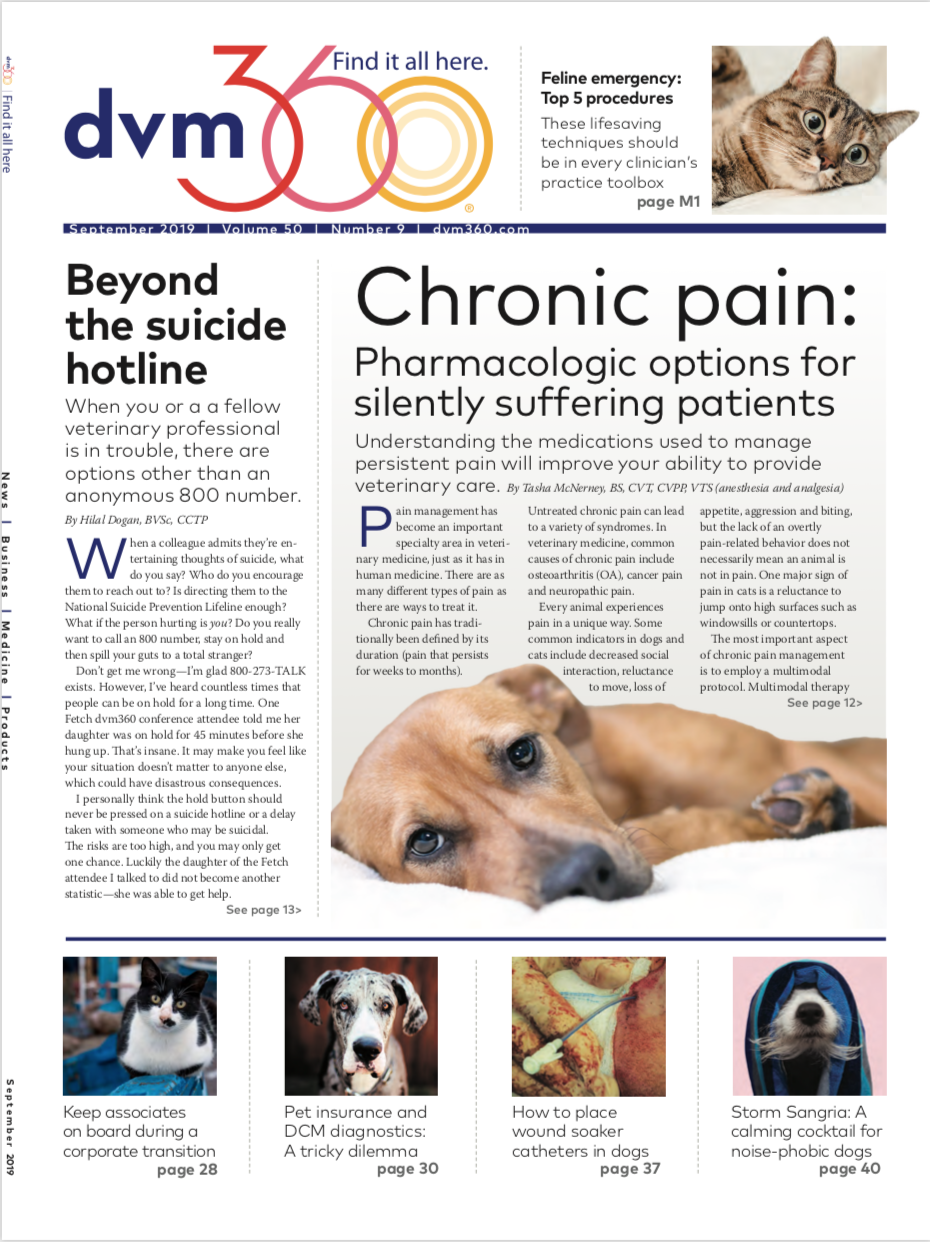Heading off chronic pain with analgesics
Understanding the medications used to manage persistent pain will improve your ability to care for your veterinary patients. Heres a rundown of the available pharmacologic options.
(Getty Images)

The most important aspect of chronic pain management is to employ a multimodal protocol.
Pain management has become an important specialty area in veterinary medicine, just as it has in human medicine. There are as many different types of pain as there are ways to treat it.
Chronic pain has traditionally been defined by its duration (pain that persists for weeks to months). Untreated chronic pain can lead to a variety of syndromes. In veterinary medicine, common causes of chronic pain include osteoarthritis (OA), cancer pain and neuropathic pain.
Every animal experiences pain in a unique way. Decreased social interaction, reluctance to move, loss of appetite, aggression and biting are some common indicators of pain in dogs and cats, but the lack of an overtly pain-related behavior does not necessarily mean an animal is not in pain. Interestingly, one major sign of pain in cats is a reluctance to jump onto high surfaces such as windowsills or countertops.
The lack of an overtly pain-related behavior does not necessarily mean an animal is not in pain.
The most important aspect of chronic pain management is to employ a multimodal protocol. Multimodal therapy involves the combined use of analgesic drugs and physical therapies to target several different points along the pain pathway, enabling more effective pain control with fewer side effects. This article discusses currently available pain medications used in veterinary medicine. (You can learn more about physical modalities for managing pain here)
Nonsteroidal anti-inflammatory drugs (NSAIDs) remain the mainstay of analgesic therapy for chronically painful patients, reducing inflammation, pain and fever. The principal mode of action of NSAIDs is to block prostaglandin production by binding and inhibiting cyclooxygenase (COX) enzymes throughout the body. However, only COX-1 produces prostaglandins that support platelets and protect the stomach. Because these prostaglandins also are reduced, NSAIDs can cause stomach and intestinal ulcers and promote bleeding.
Grapiprant (Galliprant) is a first-in-class prostaglandin receptor antagonist, a non–COX-inhibiting NSAID. It specifically targets the EP4 receptor, which is the primary mediator of canine OA pain and inflammation.
Opioids are useful in a variety of chronically painful conditions, although they may have limited effectiveness in managing some forms of neuropathic pain. Opioids are available in oral and transdermal versions. With the current opioid shortage in veterinary medicine, however, it may be advantageous to pursue other methods of analgesia.
N-methyl-D-aspartate (NMDA) receptor antagonists are often used as adjuncts (i.e. in combination with other analgesics) to improve pain control. Intense and/or chronic painful stimuli result in changes in the central nervous system's response to input, leading to an increase in pain intensity. NMDA receptor antagonist drugs help to control and treat this “amplification.” Amantadine is the most commonly used oral NMDA receptor antagonist. It was originally developed as an antiviral compound and has also been used to treat Parkinson's disease in humans.
Gabapentin has been used to manage many forms of chronic pain, although its best application may be for neuropathic pain. Gabapentin is an anticonvulsant medication with significant adjunctive anti-hyperalgesic action. It's commonly used in conjunction with opioids for pain relief in post-amputation patients. Regardless of whether gabapentin is being used for neuropathic or chronic pain, it should not be discontinued abruptly. To avoid a rebound pain effect, the dose must be stepped down.
Want to up your pain management IQ?
The International Veterinary Academy of Pain Management educates pet owners and veterinary professionals worldwide about pain management in animals. Membership in the organization offers a host of learning opportunities, including access to the latest research and developments in the field of animal pain, real-time discussion and consultation with other pain management professionals, guidance for practices that want to expand their pain management services and much more. For more information, including how you can become a certified veterinary pain practitioner, visit IVAPM.org.
Gabapentin may also be used as a sedative to help prevent stress. Pre-hospital oral administration of gabapentin in cats may make providing care easier.
Tricyclic antidepressants have been used in humans and animals as adjuncts to other analgesics (especially opioids) for chronic pain. They act to inhibit serotonin and norepinephrine reuptake, although they may have other analgesic effects as well, including possible actions at opioid receptors and on nerve transmission.
Tasha McNerney, BS, CVT, VTS (anesthesia and analgesia), is host of the Firstline series, "Coffee on the Couch." Sick of being asked, "When are you going to be a veterinarian?" and "Why aren't you a real nurse?" Tasha set out to interview veterinary professionals to elevate the profession's perspective on veterinary technicians and identify career paths for technicians. Tasha is a member of the IVAPM. She works as a technician at Rau Animal Hospital in Glenside, Pennsylvania.

Podcast CE: A Surgeon’s Perspective on Current Trends for the Management of Osteoarthritis, Part 1
May 17th 2024David L. Dycus, DVM, MS, CCRP, DACVS joins Adam Christman, DVM, MBA, to discuss a proactive approach to the diagnosis of osteoarthritis and the best tools for general practice.
Listen